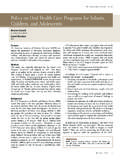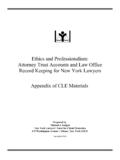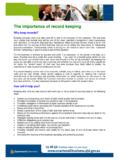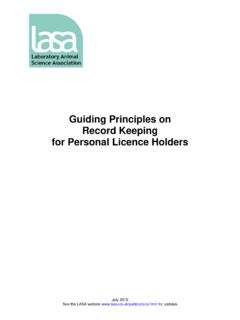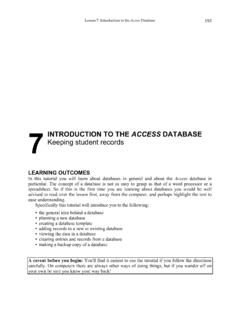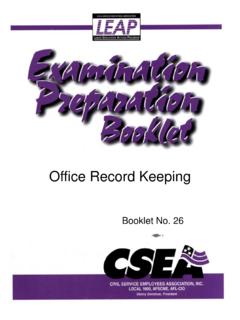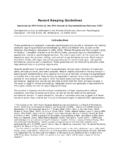Transcription of Record-keeping - Pediatric Dentistry
1 THE REFERENCE MANUAL OF Pediatric Dentistry 431 THE RFNCM AMHEU record KEEPINGP urposeThe American Academy of Pediatric Dentistry (AAPD) recognizes the patient record is an essential component of the delivery of competent and quality oral health care. It serves as an information source for the care provider and patient, as well as any authorized third party. This document will assist the practitioner in assimilating and maintaining a compre- hensive, uniform, and organized record addressing patient care. However, it is not intended to create a standard of care. MethodsThis best practice was developed by the Council on Clinical Affairs and adopted in 2004. This document is a revision of the previous version, last revised in 2012.
2 This revision in- cluded a new literature search of the PubMed /MEDLINE database using the terms: dental record , electronic patient record , problem-oriented dental record , medical history taking, medical record , record keeping , and Health Insurance Port- ability and Accountability Act (HIPAA); fields: all; limits: within the last 10 years, humans, and English. Papers for review were chosen from this list and from the references within selected articles and dental textbooks. When data did not appear sufficient or were inconclusive, recommendations were based upon expert and/or consensus opinion by experienced researchers and clinicians. BackgroundThe patient record provides all privileged parties with the history and details of patient assessment and communications between dentist and patient, as well as specific treatment rec- ommendations, alternatives, risks, and care provided.
3 The patient record is an important legal document in third party relationships. Poor or inadequate documentation of patient care consistently is reported as a major contributing factor in unfavorable legal judgments against Therefore, the AAPD recognizes that recommendation on Record-keeping may provide dentists the information needed to compile an accurate and complete patient chart that can be interpreted by a knowledgeable third-party. An electronic patient record is becoming more common- place, and perhaps will become Health information systems and electronic health records are being implemented as a means to improve the quality and efficiency of health Advantages include quality assurance by allowing comparative analysis of groups of patients or providers, medical and dental history profiles for demographic data, support for decision making based on signs and symptoms, administrative manage- ment for patient education and recall, and electronic data interchange with other professional and third parties.
4 The software must contain all the essential elements of a traditional paper record . Daily back up of the office software system should be performed and stored in an electronic data base that is retrievable by office personnel in the event that patient records are lost or damaged. The elements of Record-keeping addressed in this docu- ment are general charting considerations; initial patient record ; components of a patient record ; patient medical and dental histories; comprehensive and limited clinical examinations; treatment planning and informed consent; progress notes; correspondence, consultations, and ancillary documents; and confidential notes. Additionally, appendices to this guideline illustrate items for consideration in the development of patient medical and dental histories and examination forms.
5 These lists, developed by experts in Pediatric Dentistry and offered to facilitate excellence in practice, should be modified as needed by individual practitioners. These samples do not establish a standard of care. In issuing this information, the AAPD is not engaged in rendering legal or other professional advice. If such services are required, competent legal or other professional counsel should be sought. RecommendationsGeneral charting considerationsThe dental record must be authentic, accurate, legible, and objective. Each patient should have an individual dental rec- ord. Chart entries should contain the initials or name of the individual making the note. Abbreviations should be standardized for the practice.
6 After data collection, a list is compiled that includes medical considerations, psychological/behavior constraints, and the oral health needs to be addressed. Problems are listed in order of importance in a standardized fashion making it less likely that an area might be overlooked. The plan identifies a general course of treatment for each problem. This plan can result in the need for additional in- formation, consultation with other practitioners, patient edu- cation, and preventive AAPD: American Academy Pediatric Dentistry . HIPAA: Health Insur-ance Portability and Accountability Act. TMD: Temporomandibular disorder. TMJ: Temporomandibular Revision2017 record -keeping432 THE REFERENCE MANUAL OF Pediatric DENTISTRYTHE RFNCM AMHEU record KEEPINGI nitial patient recordThe parent s/patient s initial contact with the dental practice, usually via telephone, allows both parties an opportunity to address the patient s primary oral health needs and to confirm the appropriateness of scheduling an appointment with that particular practitioner.
7 During this conversation, the recep- tionist may record basic patient information such as: patient s name, nickname, and date of birth. name, address, and telephone number of parent. name of referring party. significant medical history. chief complaint. availability of medical/dental records (including radiographs) pertaining to patient s information constitutes the initial dental record . At the first visit to the dental office, additional information would be obtained and a permanent dental record of a patient recordThe dental record must include each of the following specific components: medical history; dental history; clinical assessment; diagnosis; treatment recommendations; progress notes; and acknowledgment of receipt of Notice of Privacy Practices/HIPAA ,6 When applicable, the following should be incorporated into the patient s record as well: radiographic assessment; caries risk assessment; parental consent/patient assent; sedation/general anesthesia records; trauma records; orthodontic records; consultations/referrals; laboratory orders.
8 Test results; and additional ancillary history7-10An accurate, comprehensive, and up-to-date medical history is necessary for correct diagnosis and effective treatment plan- ning. Familiarity with the patient s medical history is essential to decreasing the risk of aggravating a medical condition while rendering dental care. Additionally, a thorough history can aid the diagnosis of dental as well as medical conditions. The practitioner, or staff under the supervision of the practitioner, must obtain a medical history from the parent (if the patient is under the age of 18) before commencing patient care. When the parent cannot provide adequate details regarding a patient s medical history, or if the dentist providing care is unfamiliar with the patient s medical diagnosis, consultation with the medical health care provider may be indicated.
9 Documentation of the patient s medical history includes the following elements of information, with elaboration of positive findings: medical conditions and/or illnesses; name and, if available, telephone number of primary and specialty medical care providers; current therapies ( , physical, occupational, speech); hospitalizations/surgeries; anesthetic experiences; current medications; allergies/reactions to medications; other allergies/sensitivities; immunization status; review of systems; family history; and social history. Appendix I provides suggestions for specific information that may be included in the written medical questionnaire or during discussions with the patient/parent. The history form should provide the parent/legal guardian additional space for information regarding positive historical findings, as well any medical conditions not listed.
10 There should be areas on the form indicating the date of completion, the signature of the person providing the history (along with his/her relationship to the patient), and the signature of the staff member review- ing the history with the parent/legal guardian. Records of patients with significant medical conditions should be marked Medical Alert in a conspicuous yet confidential history for infants/toddlers11,12 The very young patient can present with unique develop- mental and social concerns that impact the health status of the oral cavity. Information regarding these considerations may be collected via a supplemental history questionnaire for infants/toddlers. Topics to be discussed may include a history of prematurity/perinatal complications, developmental consid-erations, feeding and dietary practices, timing of first tooth appearance, and tooth brushing initiation and timing as well as toothpaste use.



